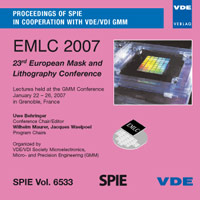EUV mask infrastructure challenges
Konferenz: EMLC 2007 - 23rd European Mask and Lithography Conference
22.01.2007 - 26.01.2007 in Grenoble, France
Tagungsband: EMLC 2007
Seiten: 12Sprache: EnglischTyp: PDF
Persönliche VDE-Mitglieder erhalten auf diesen Artikel 10% Rabatt
Autoren:
Wurm, Stefan; Seidel, Phil; Peski, Chris Van (SEMATECH, 2706 Montopolis Drive, Austin TX, 78741 USA)
He, Long; Han, Hakseung; Kearney, Pat; Cho, Wonil (SEMATECH, 255 Fuller Road, Albany NY, 12203 USA)
Inhalt:
Excellent progress has been made over the past years in meeting the demanding specifications for commercial extreme ultraviolet (EUV) mask blanks. But as EUV technology is being prepared for pilot-line introduction later this decade, a substantial effort is still required in many EUV mask infrastructure areas. These include defect inspection, reticle-handling standardization, substrate and mask flatness, and resulting overall mask cost of ownership (CoO). Defect inspection metrology for finding printable defects of < 30 nm polystyrene latex (PSL) size is a key EUV mask infrastructure enabler. To meet EUV mask blank production specifications for 32 nm half-pitch (hp) manufacturing, a next generation EUV mask blank inspection technology will be needed in 2-3 years. The industry must soon adopt standards for EUV reticle handling including carrier and loadport solutions for unified requirements to support commercial pilot-line and production tool developments. The stringent mask substrate flatness specification will be very difficult to meet and is likely to significantly increase overall EUV mask cost. The industry needs to correct for nonflatness at the various stages of a mask life cycle and must develop respective standards and specifications to determine what kind of non-flatness can be corrected. For EUV lithography to be successful, it must be affordable. Lower EUV mask costs have been a key advantage for EUV compared to optical mask extensions. To maintain this advantage, mask manufacturing and metrology methods while supporting aggressive mask specifications must remain cost competitive.


